Department of Diagnostic Radiology
The KWH introduced X-ray services in 1952. The first X-ray machine was set up at a small house (now demolished) next to the main building (currently Tung Wah Museum in the KWH). Until 1957, given the growing demand for diagnostic imaging services, the KWH Diagnostic Radiology was formally established in 1963 following the completion of the 4th phase redevelopment. Initially, one head x-ray machine was procured in addition to the one existing general X-ray machine, bringing tremendous help to the diagnostic work.
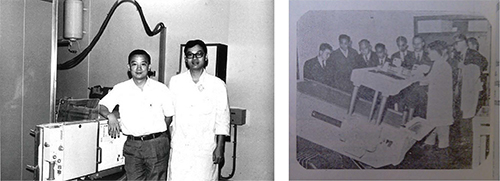
This is our first radioscope, the latest model at the time. Directors of TWGHs were shown visiting the Department (right).
At present, the KWH Diagnostic Radiology provides the public with comprehensive diagnostic imaging and treatment services including: radiological scoring, X-ray test, mammography, vacuum assisted breast biopsy, CT scanning, ultrasound scanning, MRI scanning, nuclear medicine scanning, digitalised xx imaging and interventional radiology. What’s more, diagnostic radiological services are available at TWGHs Computed Tomography Imaging Centre and TWGHs Integrated Diagnostic and Medical Centre with an annual attendance of more than 200,000, making it one of the busiest hospitals under the HA.
Various inspection rooms now serving the Hong Kong public
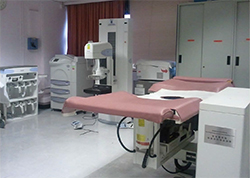
Prone breast biopsy room
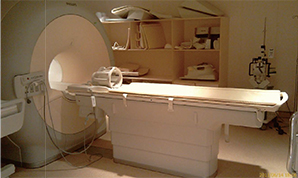
MRI scan room
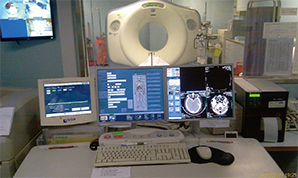
CT scan room
The Way Forward
We have been striving toward a fully digitalised imaging system, which is expected to be completed this October. The system can provide a more efficient way of saving and transmitting images to the benefit of doctors and the public, and also reduce the environmental impact caused by traditional X-ray plates. After the finalisation of the planned redevelopment of the KWH, the department will also be expanded with the introduction of more diversified, advanced diagnostic equipment which can deliver services of higher quality and efficiency.
Department of Diagnostic and Interventional Radiology
Major Development Milestones in Recent Years:
| 1963 | The Department was formally established |
| 1967 | X-ray room at A&E Department was completed; additional staff was hired by the Department for 24-hour A&E support |
| 1969 | Cerebral angiography service was provided with the introduction of Serial Changer |
| 1982 | The first CT scanner was installed at the KWH, which only provided scanning of the head and took an imaging time of 105s for each cross-sectional image (imaging time can be shorter than 1s now) |
| 1989 | The first digital subtraction angiography unit was formally installed, the most advanced of its type in Hong Kong at the time |
| 1990 | To raise public awareness of women’s health, the TWGHs set up a Well Women Clinic at the KWH to provide breast and cervical testing for women |
| 1991 | The first full-body CT scanner was set up with donation from Hong Kong Jockey Club |
| 1997 | With the completion of a large-scale renovation of the KWH, the Department enjoyed a new setting and introduction of a lot of new medical equipment, including a biplane digital subtraction angiography machine, the most advanced model at the time Cardiac Catheterisation Room was set up on 1/F, East Wing |
| 1998 | TWGHs Lee Siu Chung Memorial MRI Centre was established with donation from the TWGHs, equipped with 1.5T MRI unit, the most advanced model at the time; Cardiac Catheterisation Room came into service in April |
| 1999 | The Nuclear Medicine Centre was founded with the procurement of nuclear medicine gamma scanner donated by the TWGHs, now capable of providing various nuclear medicine tests for patients at the KWH, Our Lady of Maryknoll Hospital and TWGHs Wong Tai Sin Hospital, including cardiac/renal function tests, full-body bone scan, thyroid/lung/live scan, etc. |
| 2001 | A new vacuum assisted breast biopsy unit was added, capable of extracting small breast lumps and calcifications guided by ultrasound and X-ray |
| 2003 | SARS caused the worst pandemic in Hong Kong in recent years with 299 deaths including 6 medical personnel; the Department expanded the manpower and equipment to meet the sudden surge in demand for portable X-ray imaging |
| 2004 | The TWGHs set up a Well Men Clinic at the KWH, the first centre specially set up for men in Hong Kong to encourage regular health check-ups for men; the Clinic was later renamed TWGHs Integrated Diagnostic & Medical Centre in 2009 to align with service needs |
| 2008 | C-arm X-ray unit was introduced to replace the old X-ray machine |
| 2009 | The TWGHs introduced 320-slice dynamic volume CT scanner, the most advanced CT scanner in the world at the time. Cardiac Catheterisation Room on 1/F, East Wing was also enhanced with newer, better biplane cardiac catheterisation testing equipment |
| Sept 2009 | Full digitisation for Mammography service |
| 2010 | A digitalised X-ray system was set up at Tsui Tsin Tong Out-patient Building, allowing instant transmission of X-ray images to other medical information systems, which not only reduces waiting time but also saves patients the need to commute between Out-patient Building and Main Building |
| Nov 2011 | Filmless KWH except NM modality |
| Jan 2014 | New SPECT(Single Photon Emission Computerized Tomography) CT machine, Full Filmless in the KWH |
| Dec 2014 | New department name – Department of Diagnostic and Interventional Radiology to truly reflect the service provided by our department. |
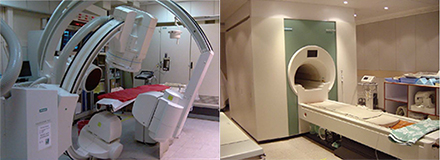
Biplane digital subtraction angiography machine & 1.5T MRI unit, the most advanced models at the time
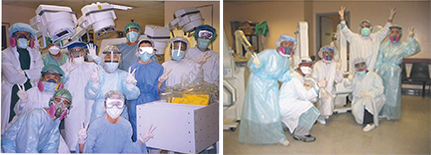
Our staff remained motivated in service of the public despite difficulties during the pandemic.
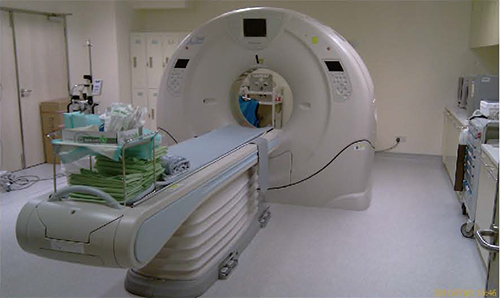
320-slice dynamic volume CT scanner, the most advanced of its type in the world, serving the public

